Combined Environmental and Economic Assessment of Energy Efficiency Measures in a Multi-Dwelling Building
Abstract
1. Introduction
2. Methodology
2.1. Case Study
2.2. Energy Simulation
2.3. Life Cycle Assessment
2.3.1. Life Cycle Inventory
2.3.2. Life Cycle Impact Assessment
2.4. Life Cycle Costs
Parameters of the Analysis
2.5. Combined LCA-LCC
2.6. Sensitivity Analysis
3. Results
3.1. Life Cycle Assessment
3.2. Life Cycle Costs
3.3. Combined Life Cycle Assessment and Life Cycle Costs Results
- (1)
- The ones that rely on PV (1 and 5) which mainly have a negative environmental impact due to the reduction of already carbon poor electricity;
- (2)
- the ones that use district heating with relative improvements of GWP (3 and 7); and
- (3)
- the ones with changed energy carriers (2, 4, 6 and 8).
3.4. Sensitivity Analysis
4. Discussion
4.1. On the Results
4.2. On the Methodology
5. Conclusions
Supplementary Materials
Author Contributions
Funding
Acknowledgments
Conflicts of Interest
References
- United Nations Transforming Our World: The 2030 Agenda for Sustainable Development 2015. Available online: https://sustainabledevelopment.un.org/post2015/transformingourworld (accessed on 16 March 2019).
- World Green building Council. The Sustainable Development Goals World Green Building Council. Available online: https://www.worldgbc.org/green-building-sustainable-development-goals (accessed on 14 February 2019).
- European Parliament, Council of the European Union. EU Directive 2010/31/EU of the European Parliament and of the Council of 19 May 2010 on the energy performance of buildings. Off. J. Eur. Union 2010, 13–35. [Google Scholar] [CrossRef]
- Vilches, A.; Garcia-Martinez, A.; Sanchez-Montã, B. Life cycle assessment (LCA) of building refurbishment: A literature review. Energy Build. 2017, 135, 286–301. [Google Scholar] [CrossRef]
- Ma, Z.; Cooper, P.; Daly, D.; Ledo, L. Existing building retrofits: Methodology and state-of-the-art. Energy Build. 2012, 55, 889–902. [Google Scholar] [CrossRef]
- Moschetti, R.; Brattebø, H.; Skeie, K.S.; Lien, A.G. Performing quantitative analyses towards sustainable business models in building energy renovation projects: Analytic process and case study. J. Clean. Prod. 2018, 199, 1092–1106. [Google Scholar] [CrossRef]
- Malmgren, L.; Mjörnell, K.; Malmgren, L.; Mjörnell, K. Application of a Decision Support Tool in Three Renovation Projects. Sustainability 2015, 7, 12521–12538. [Google Scholar] [CrossRef]
- Pombo, O.; Rivela, B.; Neila, J. Life cycle thinking toward sustainable development policy-making: The case of energy retrofits. J. Clean. Prod. 2019, 206, 267–281. [Google Scholar] [CrossRef]
- Nemry, F.; Uihlein, A.; Colodel, C.M.; Wetzel, C.; Braune, A.; Wittstock, B.; Hasan, I.; Kreißig, J.; Gallon, N.; Niemeier, S.; et al. Options to reduce the environmental impacts of residential buildings in the European Union—Potential and costs. Energy Build. 2010, 42, 976–984. [Google Scholar] [CrossRef]
- Ostermeyer, Y.; Wallbaum, H.; Reuter, F. Multidimensional Pareto optimization as an approach for site-specific building refurbishment solutions applicable for life cycle sustainability assessment. Int. J. Life Cycle Assess. 2013, 18, 1762–1779. [Google Scholar] [CrossRef]
- Cetiner, I.; Edis, E. An environmental and economic sustainability assessment method for the retrofitting of residential buildings. Energy Build. 2014, 74, 132–140. [Google Scholar] [CrossRef]
- Pombo, O.; Allacker, K.; Rivela, B.; Neila, J. Sustainability assessment of energy saving measures: A multi-criteria approach for residential buildings retrofitting—A case study of the Spanish housing stock. Energy Build. 2016, 116, 384–394. [Google Scholar] [CrossRef]
- Gonzalez, F.J.N.; Touceda, M.; Richard, A.; Degrez, M. Methodology proposal for the life cycle sustainability assessment applied to retrofitting in a local context. World Sustain. Build. Conf. Wsb14 2014, 3, 235–242. [Google Scholar]
- European Commitee for Standarization. Sustainability of Construction Work—Assessment of Environmental Performance of Buildings—Calculation Methods; (CEN) EN 15978; European Commitee for Standarization: Brussels, Belgium, 2011. [Google Scholar]
- European Commitee for Standarization (CEN) EN 16627. Sustainability of construction work—Assessment of Economic Performance of Buildings—Calculation Methods; European Commitee for Standarization: Brussels, Belgium, 2015. [Google Scholar]
- EQUA Use Manual IDA Indoor Climate and Energy; EQUA: Stockholm, Sweden, 2013.
- Ramírez-Villegas, R.; Eriksson, O.; Olofsson, T. Assessment of renovation measures for a dwelling area—Impacts on energy efficiency and building certification. Build. Env. 2016, 97, 26–33. [Google Scholar] [CrossRef]
- European Commission, Joint Research Centre (JRC). JRC Photovoltaic Geographical Information System (PVGIS)—European Commission. Available online: http://re.jrc.ec.europa.eu/ (accessed on 5 February 2019).
- Ramírez-Villegas, R.; Eriksson, O.; Olofsson, T. Life Cycle Assessment of Building Renovation Measures–Trade-off between Building Materials and Energy. Energies 2019, 12, 344. [Google Scholar] [CrossRef]
- Regelsamling för energideklaration med kommentarer; Boverket: Karlskrona, Sweden, 2010; ISBN 9789186342586.
- Gustafsson, M. Energy Efficient Renovation Strategies for Swedish and Other European Residential and Office Buildings. PhD Thesis, KTH Royal Institute of Technology, Stockholm, Sweden, 9 May 2017. [Google Scholar]
- Müller, V.R. BKI Baupreise Kompakt 2017—Neubau: Statistische Baupreise für Positionen mit Kurztexten; Müller Rudolf: Cologne, Germany, 2016; ISBN 9783481034788. [Google Scholar]
- AECOM. Spon’s Architects’ and Builders’ Price Book; Spon’s Price Books; CRC Press: Boca Raton, FL, USA, 2018; ISBN 9780429875793. [Google Scholar]
- International Labour Organization Labour Costs. Available online: https://www.ilo.org/ilostat/faces/oracle/webcenter/portalapp/pagehierarchy/Page3.jspx?MBI_ID=443&_afrLoop=1112617909900872&_afrWindowMode=0&_afrWindowId=1a9o9sak28_1#!%40%40%3F_afrWindowId%3D1a9o9sak28_1%26_afrLoop%3D1112617909900872%26MBI_ID%3D443%26_afr (accessed on 6 March 2019).
- Lufkin, P.S.; Miller, J.; Romani, L.; Towers, M. The Whitestone Facility Maintenance and Repair Cost Reference 2009-2010; Whitestone Research Corporation: Santa Barbara, CA, USA, 2009; ISBN 9780967062990. [Google Scholar]
- Lufkin, P.; Abate, D.; Romani, L.; Towers, M.; Dotz, R.; Miller, J. The Whitestone Facility Operations Cost Reference 2014-2015, North. America; Whitestone Research Corporation: Santa Barbara, CA, USA, 2014; ISBN 9780989774338. [Google Scholar]
- Bionova LCC Tool, Assessment Scope and Costing Database. Available online: https://desk.zoho.eu/portal/oneclicklca/kb/articles/lcc-assessment-scope-and-costing-database (accessed on 6 March 2019).
- International Energy Agency. Electricity Information 2018; IEA Publications: Paris, France, 2018; ISBN 978-92-64-30120-7. [Google Scholar]
- Swedish National Audit Office. Support to Solar Power (RiR 2017:29); Swedish National Audit Office: Stockholm, Sweden, 2017. [Google Scholar]
- Solelkommissionen Energiskatt. Available online: http://www.solelkommissionen.se/energiskatt/ (accessed on 2 April 2019).
- Eriksson, O. Nuclear Power and Resource Efficiency—A Proposal for a Revised Primary Energy Factor. Sustainability 2017, 9, 1063. [Google Scholar] [CrossRef]
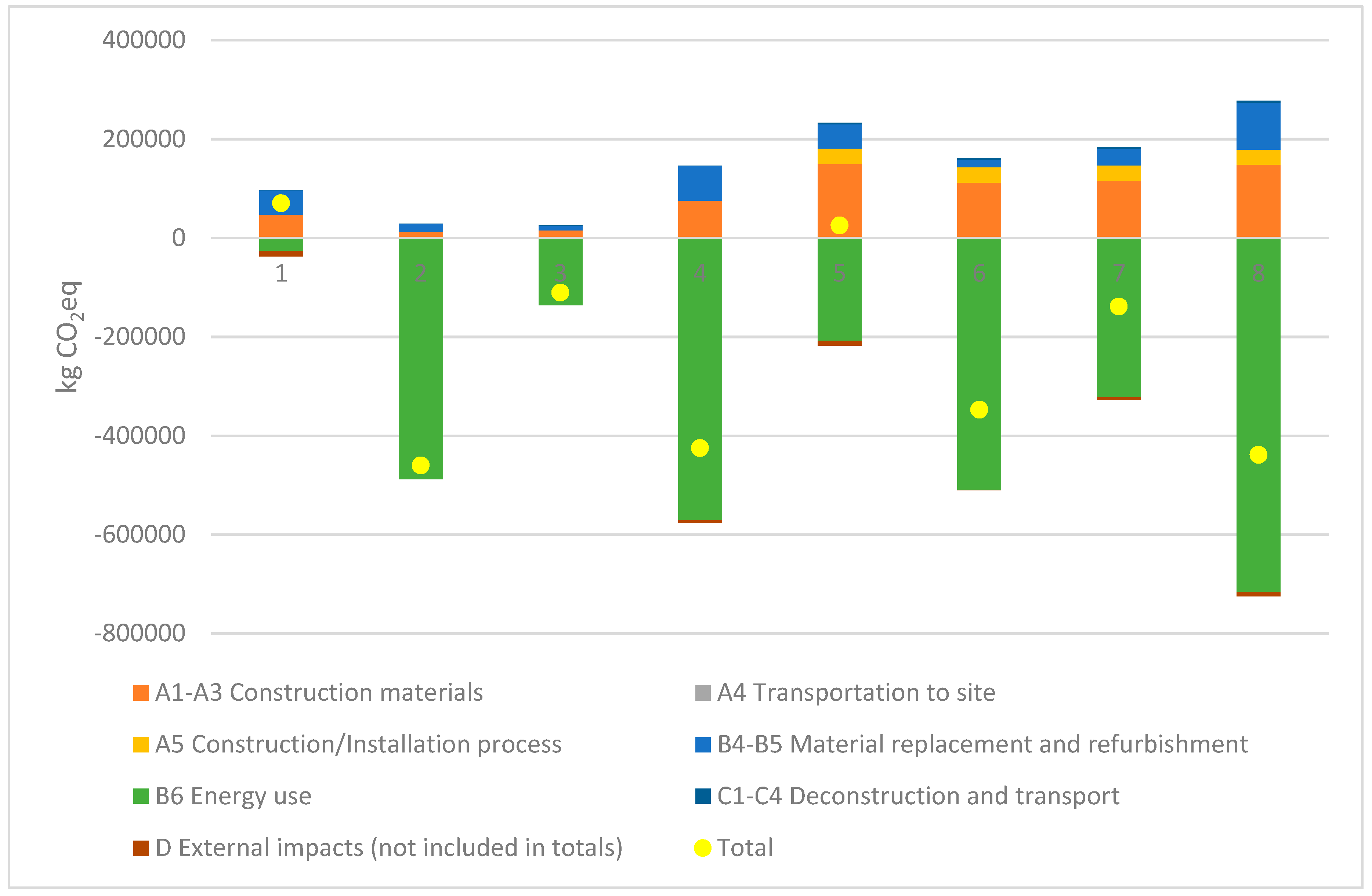
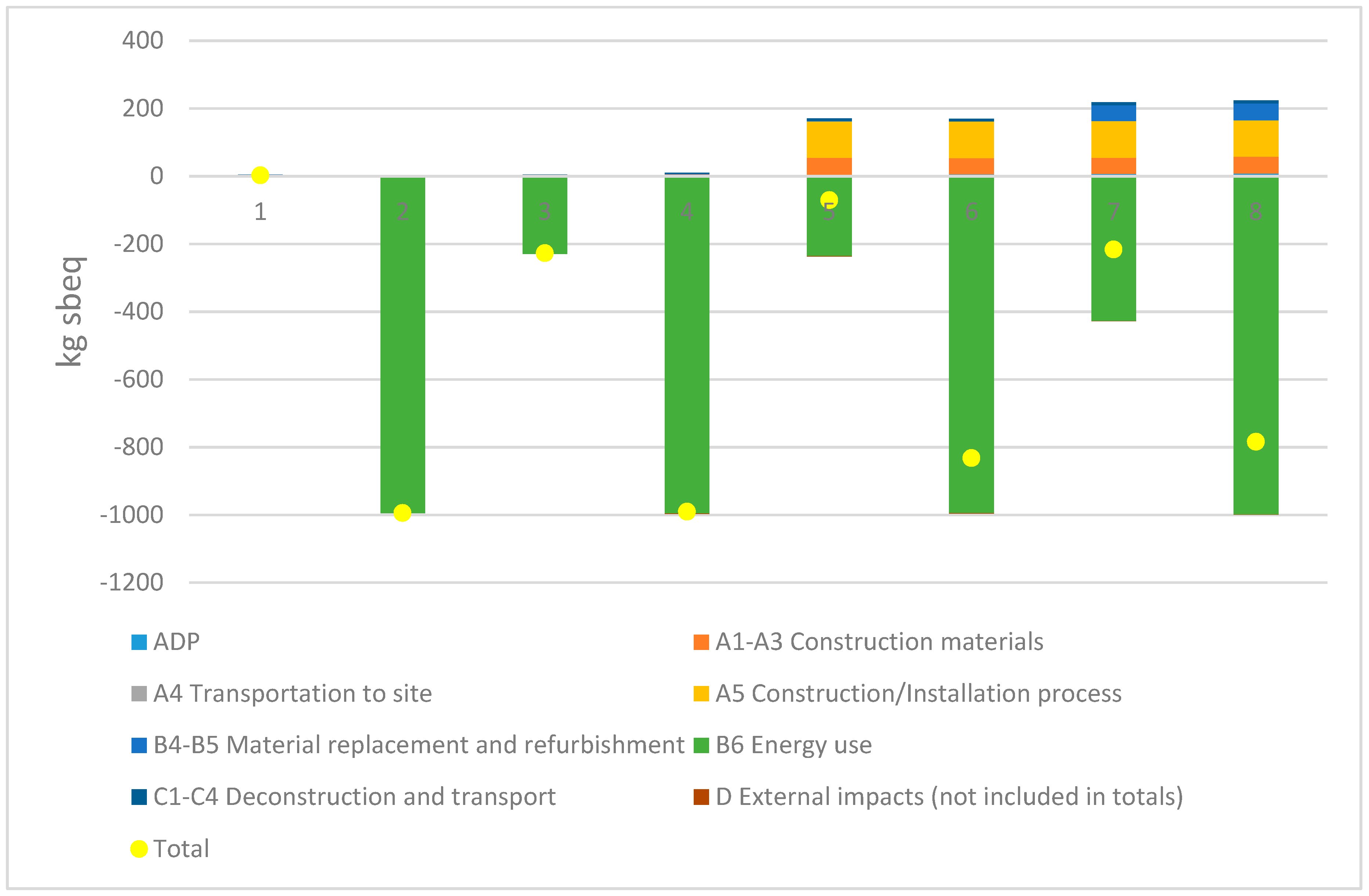

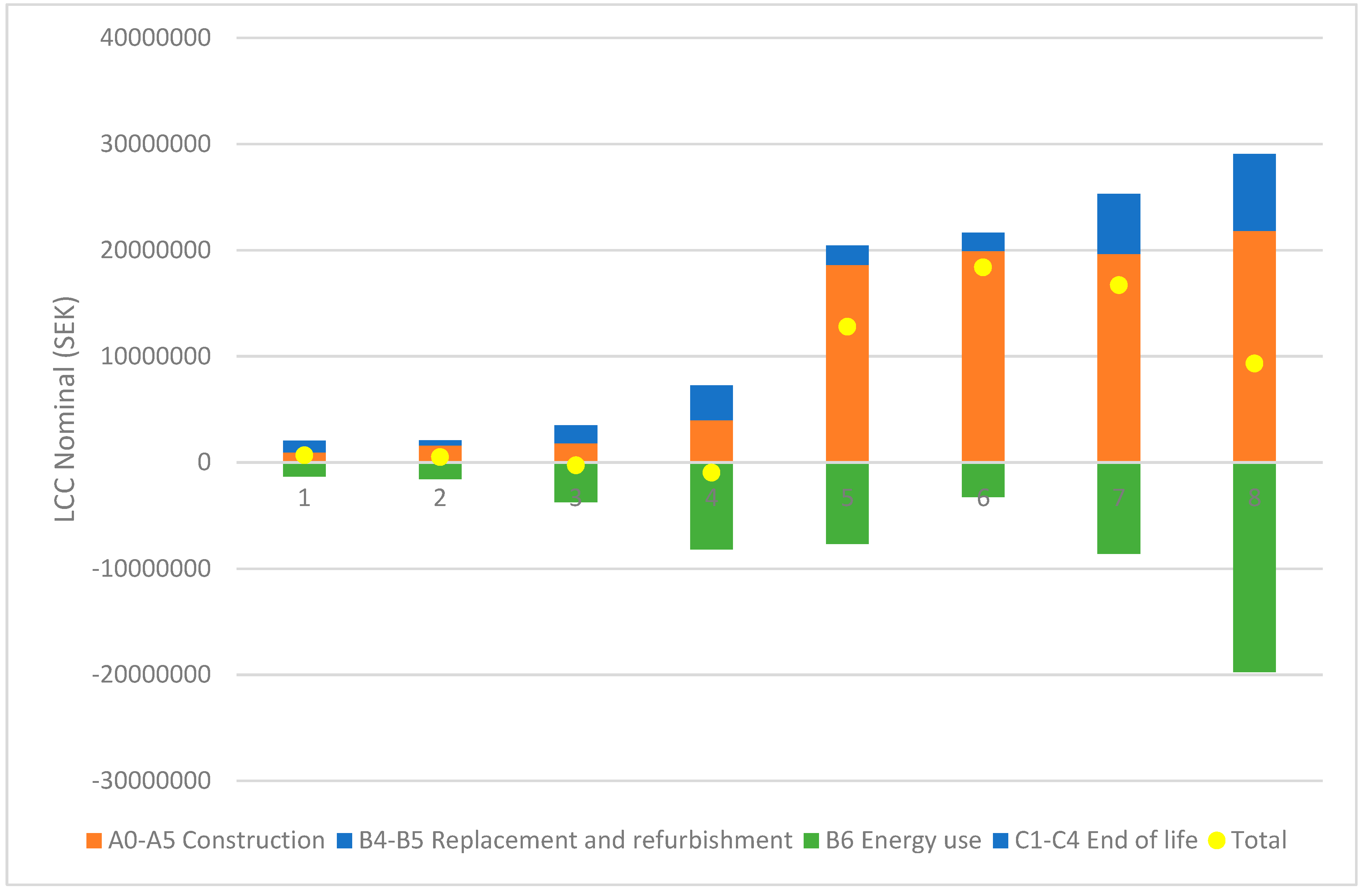
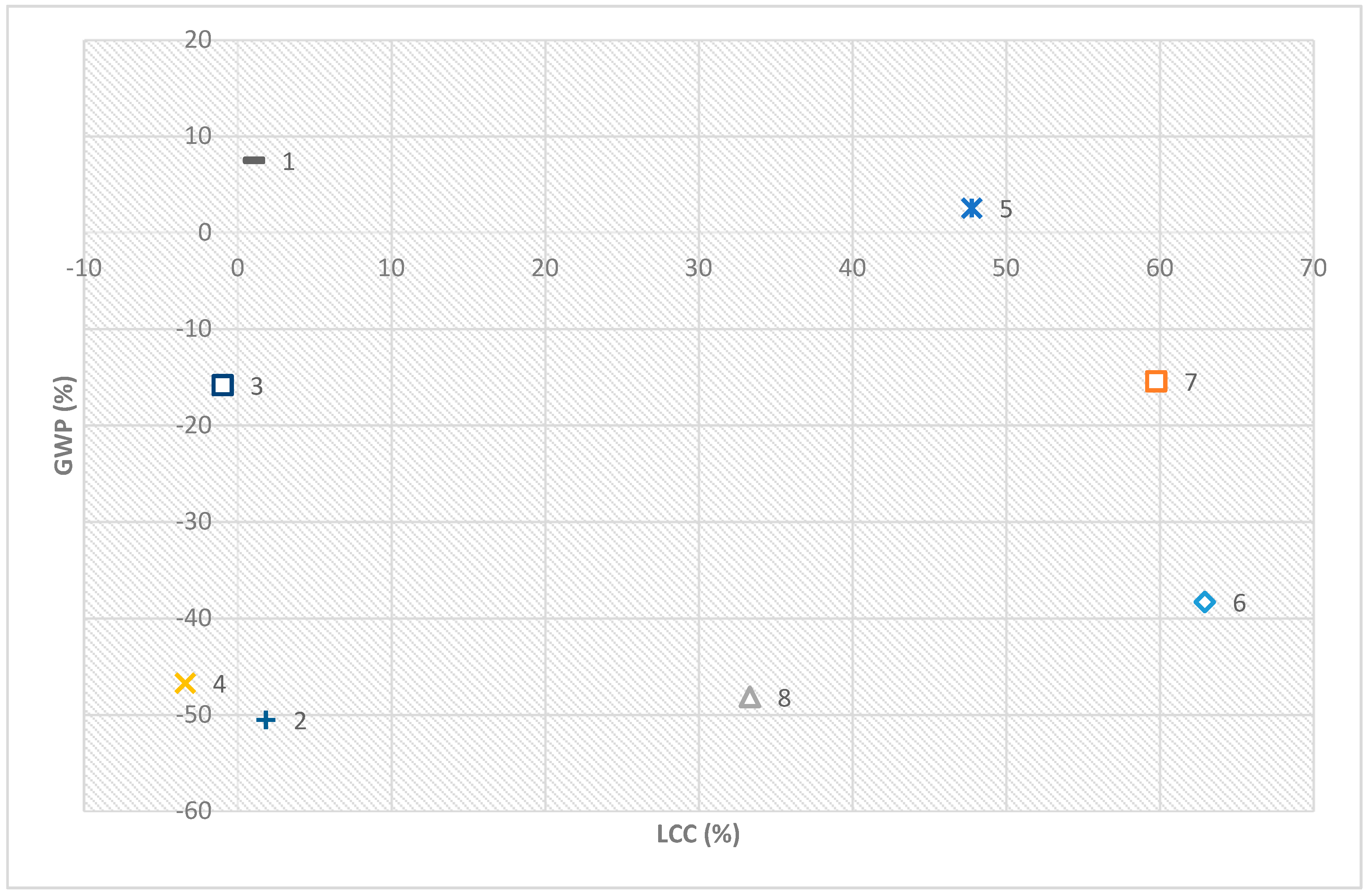
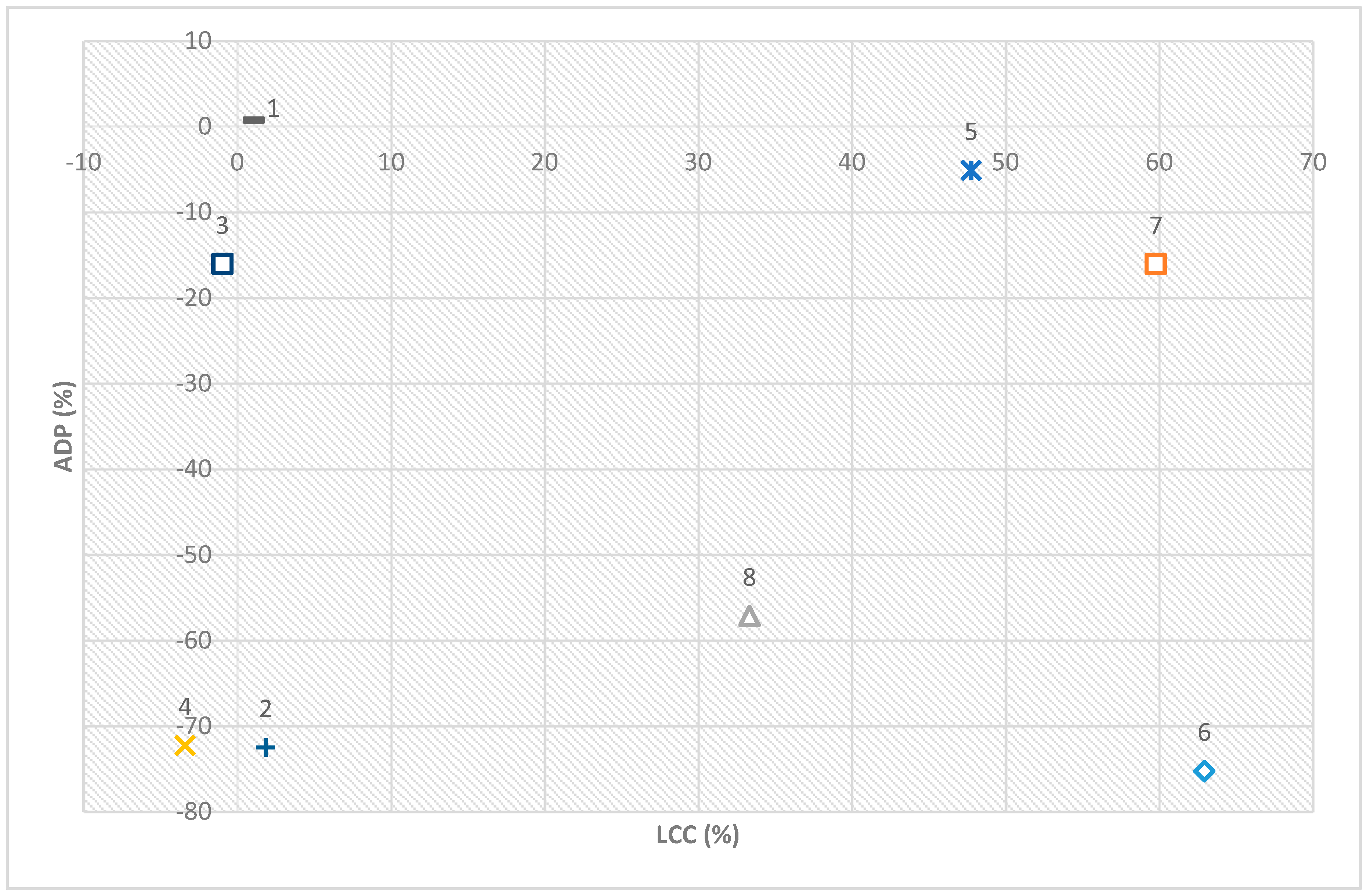
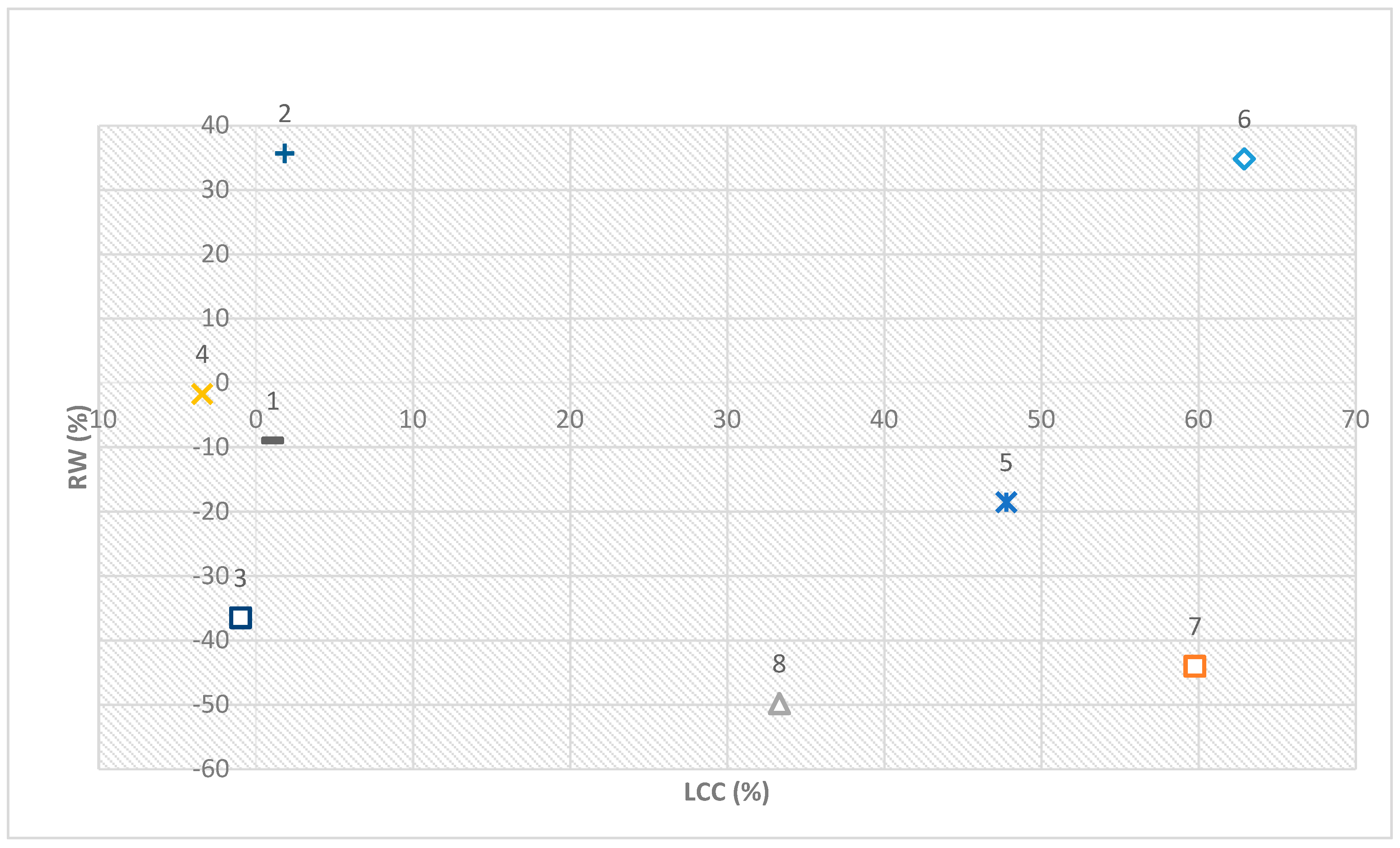
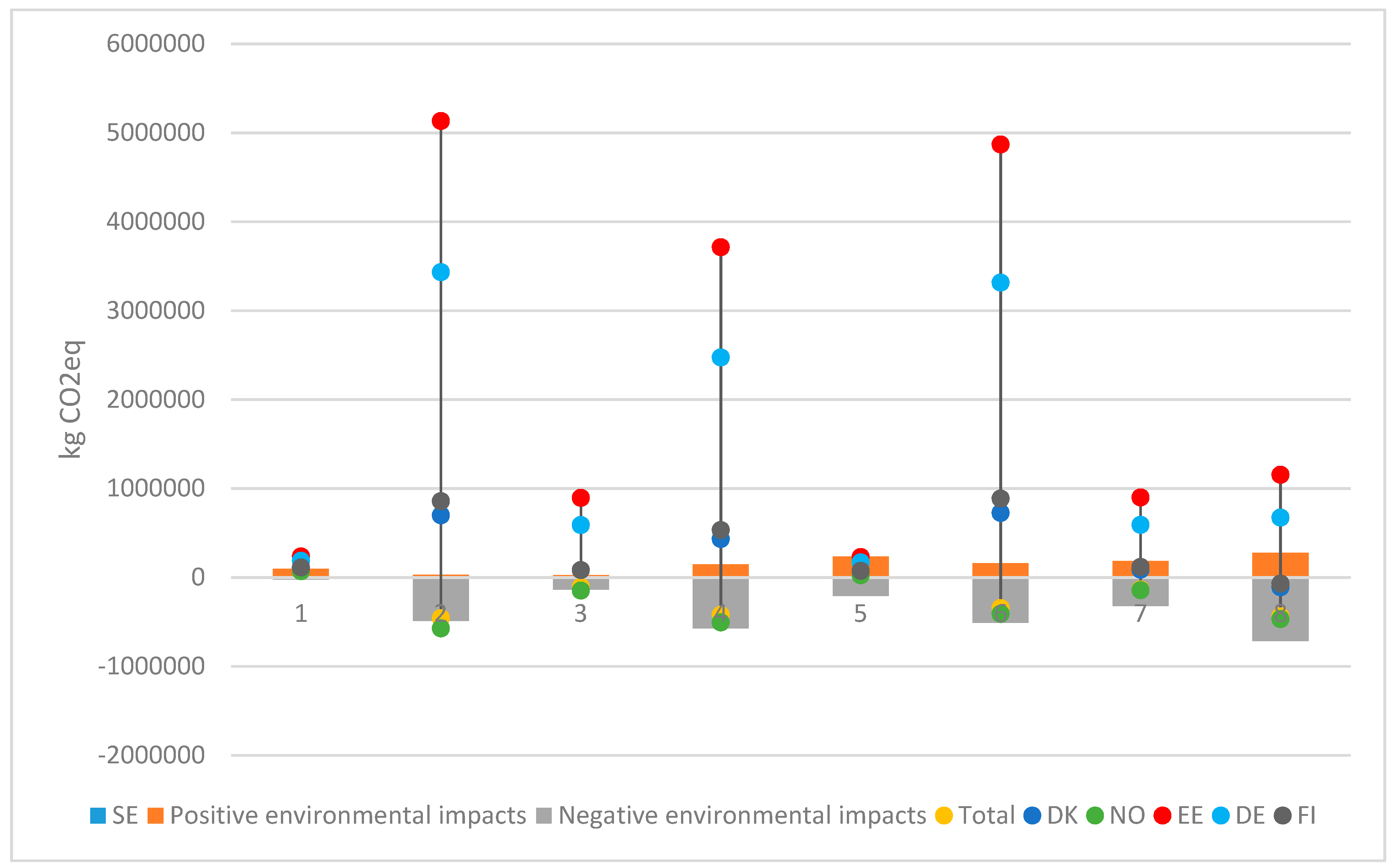
| Renovation Measure | 0 | 1 | 2 | 3 | 4 | 5 | 6 | 7 | 8 |
|---|---|---|---|---|---|---|---|---|---|
| Heat Recovery Ventilation | - | - | - | X | X | - | - | X | X |
| Photovoltaic panels | - | X | - | - | X | X | - | - | X |
| Geothermal Heat Pump | - | - | X | - | X | - | X | - | X |
| 480 mm outer wall insulation | - | - | - | - | - | X | X | X | X |
| 300 mm attic insulation | - | - | - | - | - | X | X | X | X |
| 3-glass argon-filled low-emissivity pane windows | - | - | - | - | - | X | X | X | X |
| Resource | Quantity | Unit | Service Life |
|---|---|---|---|
| Electric heat pump (brine-water, geothermal probe), 70 kW (Coefficient of performance (COP):3) | 1 | Pcs | 20 |
| Pipework for electric heat pump (brine-water, geothermal collector), 70 kW | 1 | Pcs | 50 |
| Photovoltaic panel system for roofs, 300 Wp capacity | 134 | m2 | 30 |
| Factor | Value |
|---|---|
| Calculation period (Years) | 50 |
| Discount rate (cost of capital) (%) | 7 |
| Regional material cost index (%) | 1.3 |
| Inflation rate (%) | 2 |
| End of Life (EOL) as % of Capital Expenses (%) | 2.5 |
| Hourly labor rate, worker (SEK) | 306.1 |
| Hourly labor rate, craftsman (SEK) | 413.3 |
| Scenario | 0 | 1 | 2 | 3 | 4 | 5 | 6 | 7 | 8 |
|---|---|---|---|---|---|---|---|---|---|
| District heating use (kWh/m2) | 134 | 134 | - | 109 | - | 108 | - | 91 | - |
| Electricity use (kWh/m2) | 6 | 1.5 | 47 | 9 | 43 | 1.8 | 43 | 9 | 21 |
| Country | Nuclear | Oil | Waste | Hydro | Solar PV | Wind | Biofuels | Coal | Gas |
|---|---|---|---|---|---|---|---|---|---|
| Sweden (SE) | 40.4 | 0.3 | 2.1 | 39.8 | 0.1 | 9.9 | 6.3 | 0.7 | 0.4 |
| Denmark (DK) | 0 | 1.1 | 5.1 | 0.1 | 2.4 | 41.9 | 13.3 | 29 | 7.1 |
| Norway (NO) | 0 | 0 | 0.3 | 96.4 | 0 | 1.4 | 0 | 0.1 | 1.7 |
| Estonia (EE) | 0 | 2.1 | 1.1 | 0 | 0 | 4.9 | 7.3 | 83.8 | 0 |
| Finland (FI) | 33.9 | 0.3 | 1.4 | 23.1 | 0 | 4.5 | 16.1 | 15.3 | 5.5 |
| Germany (DE) | 13.1 | 0.9 | 2 | 4 | 5.9 | 12.1 | 7 | 42.2 | 12.7 |
© 2019 by the authors. Licensee MDPI, Basel, Switzerland. This article is an open access article distributed under the terms and conditions of the Creative Commons Attribution (CC BY) license (http://creativecommons.org/licenses/by/4.0/).
Share and Cite
Ramírez-Villegas, R.; Eriksson, O.; Olofsson, T. Combined Environmental and Economic Assessment of Energy Efficiency Measures in a Multi-Dwelling Building. Energies 2019, 12, 2484. https://doi.org/10.3390/en12132484
Ramírez-Villegas R, Eriksson O, Olofsson T. Combined Environmental and Economic Assessment of Energy Efficiency Measures in a Multi-Dwelling Building. Energies. 2019; 12(13):2484. https://doi.org/10.3390/en12132484
Chicago/Turabian StyleRamírez-Villegas, Ricardo, Ola Eriksson, and Thomas Olofsson. 2019. "Combined Environmental and Economic Assessment of Energy Efficiency Measures in a Multi-Dwelling Building" Energies 12, no. 13: 2484. https://doi.org/10.3390/en12132484
APA StyleRamírez-Villegas, R., Eriksson, O., & Olofsson, T. (2019). Combined Environmental and Economic Assessment of Energy Efficiency Measures in a Multi-Dwelling Building. Energies, 12(13), 2484. https://doi.org/10.3390/en12132484







